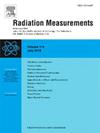Perovskite scintillators for X-ray detection and imaging
IF 2.2
3区 物理与天体物理
Q2 NUCLEAR SCIENCE & TECHNOLOGY
引用次数: 0
Abstract
Perovskite scintillators have emerged as one class of competitive scintillators for next-generation X-ray detection and imaging due to their unique properties, including high atomic number (Z), superior radiation absorption capability, high photoluminescence quantum yield (PLQY), ultrafast response time, excellent spatial resolution, and low-cost fabrication. The tunable structure and versatile chemical compositions of perovskite scintillators provide distinguishable advantages over traditional inorganic scintillators for optimizing scintillation performance. This review briefly outlines the historical development of scintillators and categorizes perovskite-based scintillators based on their structural characteristics, introducing key performance parameters and evaluation criteria. Recent progress is then summarized in three major application domains: high-resolution X-ray imaging, ultrafast dynamic imaging, and multi-energy spectral imaging. The discussion highlights representative achievements and technical challenges associated with light yield, temporal response, and image resolution. Finally, current research bottlenecks, such as poor environmental stability, fabrication complexity, and system integration issues, are examined, and potential strategies for future development are proposed, including material optimization, structural engineering, and interdisciplinary system-level integration. This review aims to provide a comprehensive understanding of perovskite scintillators and promote their practical implementation in advanced radiation detection technologies.
用于x射线探测和成像的钙钛矿闪烁体
钙钛矿闪烁体由于其独特的性能,包括高原子序数(Z)、优越的辐射吸收能力、高光致发光量子产率(PLQY)、超快的响应时间、优异的空间分辨率和低成本的制造,已成为下一代x射线探测和成像的一类有竞争力的闪烁体。钙钛矿闪烁体的结构可调,化学成分多样,与传统无机闪烁体相比,具有明显的优势,可以优化闪烁性能。本文简要概述了闪烁体的历史发展,并根据其结构特点对钙钛矿基闪烁体进行了分类,介绍了关键性能参数和评价标准。总结了高分辨率x射线成像、超快动态成像和多能谱成像三个主要应用领域的最新进展。讨论重点突出了与光产率、时间响应和图像分辨率相关的代表性成就和技术挑战。最后,分析了当前的研究瓶颈,如环境稳定性差、制造复杂性和系统集成问题,并提出了未来发展的潜在策略,包括材料优化、结构工程和跨学科系统级集成。本文综述旨在提供对钙钛矿闪烁体的全面认识,并促进其在先进辐射探测技术中的实际应用。
本文章由计算机程序翻译,如有差异,请以英文原文为准。
求助全文
约1分钟内获得全文
求助全文
来源期刊

Radiation Measurements
工程技术-核科学技术
CiteScore
4.10
自引率
20.00%
发文量
116
审稿时长
48 days
期刊介绍:
The journal seeks to publish papers that present advances in the following areas: spontaneous and stimulated luminescence (including scintillating materials, thermoluminescence, and optically stimulated luminescence); electron spin resonance of natural and synthetic materials; the physics, design and performance of radiation measurements (including computational modelling such as electronic transport simulations); the novel basic aspects of radiation measurement in medical physics. Studies of energy-transfer phenomena, track physics and microdosimetry are also of interest to the journal.
Applications relevant to the journal, particularly where they present novel detection techniques, novel analytical approaches or novel materials, include: personal dosimetry (including dosimetric quantities, active/electronic and passive monitoring techniques for photon, neutron and charged-particle exposures); environmental dosimetry (including methodological advances and predictive models related to radon, but generally excluding local survey results of radon where the main aim is to establish the radiation risk to populations); cosmic and high-energy radiation measurements (including dosimetry, space radiation effects, and single event upsets); dosimetry-based archaeological and Quaternary dating; dosimetry-based approaches to thermochronometry; accident and retrospective dosimetry (including activation detectors), and dosimetry and measurements related to medical applications.
 求助内容:
求助内容: 应助结果提醒方式:
应助结果提醒方式:


